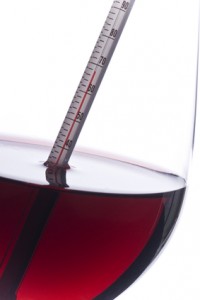 A liquid’s temperature plays a critical role in taste and smell. So much so that tasting a drink at the wrong temperature can ruin the experience. Just consider your reaction to warm, flat soda or room temperature coffee. Yuck, right?
A liquid’s temperature plays a critical role in taste and smell. So much so that tasting a drink at the wrong temperature can ruin the experience. Just consider your reaction to warm, flat soda or room temperature coffee. Yuck, right?
The same goes for wine. This is why some wine lovers tend to obsess about correct serving temperatures. Serving a wine at its ideal temperature brings out the wine’s depth of taste and aromas. Red wines that are served too warm lose fruit and structure leaving only the taste of tannin and alcohol. White wine served too cold rarely has any flavor at all beyond alcohol.
The only white wines that should be served very cold are the very inexpensive ones. Most of these wines are simple in their flavors and aromas.Sparkling wines and Champagne are also best when cold. Not only does the cold help retain bubbles when opening, but many people enjoy the wine’s texture when colder.
For other white wines and even expensive or mature bubbly, these are best served on the cooler rather than cold side, think 45 to 52 degrees. The reason it’s important is because if the wine is too cold, you lose all of the aromas and you are unable to appreciate the subtle, delicate aromas most of these wines offer.
When it comes to red wines, most of us have them sitting around on a wine rack at what we consider room temperature, but the old adage of serving red wine at room temperature doesn’t really apply. In reality, most of us keep our thermostats set between 68 to 75 degrees, depending on the time of year. This is far too warm for serving most red wines. But because lower temperatures will make a high-tannin wine like cabernet sauvignon even more tannic and bitter, it is wise to not serve them cold. Most red wines taste best served between 58 and 65 degrees. If you don’t have temperature-controlled storage for red wines, don’t be afraid to pop it in the refrigerator for a quick 5- to10-minute chill. If it’s summer, even placing the wine near an air-conditioning vent for a few hours will get the job done.
When dining out, it takes confidence to voice your opinion on what the wine’s temperature is when you are served. But your server needs to be aware of this issue. You wouldn’t think twice about pointing out a cold cup of coffee or undercooked food, and it should be the same with wine. Asking for an ice bucket for your white wine throughout dinner or one for a quick cool down of your reds can improve the overall enjoyment of your dining experience.